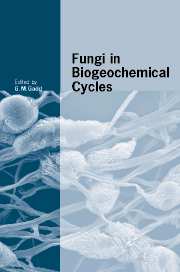Book contents
- Frontmatter
- Contents
- List of Contributors
- Preface
- 1 Geomicrobiology: relative roles of bacteria and fungi as geomicrobial agents
- 2 Integrated nutrient cycles in boreal forest ecosystems – the role of mycorrhizal fungi
- 3 Fungal roles in transport processes in soils
- 4 Water dynamics of mycorrhizas in arid soils
- 5 Integrating ectomycorrhizal fungi into quantitative frameworks of forest carbon and nitrogen cycling
- 6 Role of arbuscular mycorrhizal fungi in carbon and nutrient cycling in grassland
- 7 The role of wood decay fungi in the carbon and nitrogen dynamics of the forest floor
- 8 Relative roles of bacteria and fungi in polycyclic aromatic hydrocarbon biodegradation and bioremediation of contaminated soils
- 9 Biodegradation and biodeterioration of man-made polymeric materials
- 10 Fungal dissolution and transformation of minerals: significance for nutrient and metal mobility
- 11 Fungal activities in subaerial rock-inhabiting microbial communities
- 12 The oxalate–carbonate pathway in soil carbon storage: the role of fungi and oxalotrophic bacteria
- 13 Mineral tunnelling by fungi
- 14 Mineral dissolution by ectomycorrhizal fungi
- 15 Lichen biogeochemistry
- 16 Fungi in subterranean environments
- 17 The role of fungi in carbon and nitrogen cycles in freshwater ecosystems
- 18 Biogeochemical roles of fungi in marine and estuarine habitats
- Index
- References
3 - Fungal roles in transport processes in soils
Published online by Cambridge University Press: 10 December 2009
- Frontmatter
- Contents
- List of Contributors
- Preface
- 1 Geomicrobiology: relative roles of bacteria and fungi as geomicrobial agents
- 2 Integrated nutrient cycles in boreal forest ecosystems – the role of mycorrhizal fungi
- 3 Fungal roles in transport processes in soils
- 4 Water dynamics of mycorrhizas in arid soils
- 5 Integrating ectomycorrhizal fungi into quantitative frameworks of forest carbon and nitrogen cycling
- 6 Role of arbuscular mycorrhizal fungi in carbon and nutrient cycling in grassland
- 7 The role of wood decay fungi in the carbon and nitrogen dynamics of the forest floor
- 8 Relative roles of bacteria and fungi in polycyclic aromatic hydrocarbon biodegradation and bioremediation of contaminated soils
- 9 Biodegradation and biodeterioration of man-made polymeric materials
- 10 Fungal dissolution and transformation of minerals: significance for nutrient and metal mobility
- 11 Fungal activities in subaerial rock-inhabiting microbial communities
- 12 The oxalate–carbonate pathway in soil carbon storage: the role of fungi and oxalotrophic bacteria
- 13 Mineral tunnelling by fungi
- 14 Mineral dissolution by ectomycorrhizal fungi
- 15 Lichen biogeochemistry
- 16 Fungi in subterranean environments
- 17 The role of fungi in carbon and nitrogen cycles in freshwater ecosystems
- 18 Biogeochemical roles of fungi in marine and estuarine habitats
- Index
- References
Summary
Introduction
Fundamentally, biogeochemical cycling involves the transformation of compounds between various forms, and a movement of such compounds within and between compartments of the biosphere and geosphere. These processes operate across a wide range of spatial and temporal scales, from micrometres to kilometres, from seconds to centuries. In terrestrial systems, transformations and movement of materials below-ground are governed by the spatial organization of the soil system, and particularly the architecture of the pore network. This ‘inner space’ provides the physical framework in and through which the majority of soil-based processes occur. The labyrinthine nature of the pore network, and the exchange properties of associated surfaces, strongly modulates the transport of materials through the soil matrix. From a physicochemical perspective soil structure generally retards transport processes for two main reasons: the complex geometry of the pore network increases path lengths, both for diffusive and bulk-flow movement; and charged mineral and organic constituents in the soil act as exchange surfaces which bind transportable compounds to varying degrees. Transport processes may also be accelerated by structural properties, for example if solutes or particulates are carried via preferential and bypass-flow channels of water through macropores.
Soil organisms play a key role in driving terrestrial nutrient cycling, and play both direct and indirect roles in effecting and affecting transport processes. Fungi contribute a particularly wide range of functions relating to nutrient cycling.
- Type
- Chapter
- Information
- Fungi in Biogeochemical Cycles , pp. 51 - 73Publisher: Cambridge University PressPrint publication year: 2006
References
- 7
- Cited by



